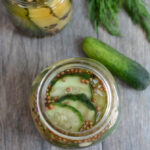These Easy Refrigerator Pickles are a simple, budget-friendly alternative to store-bought pickles.
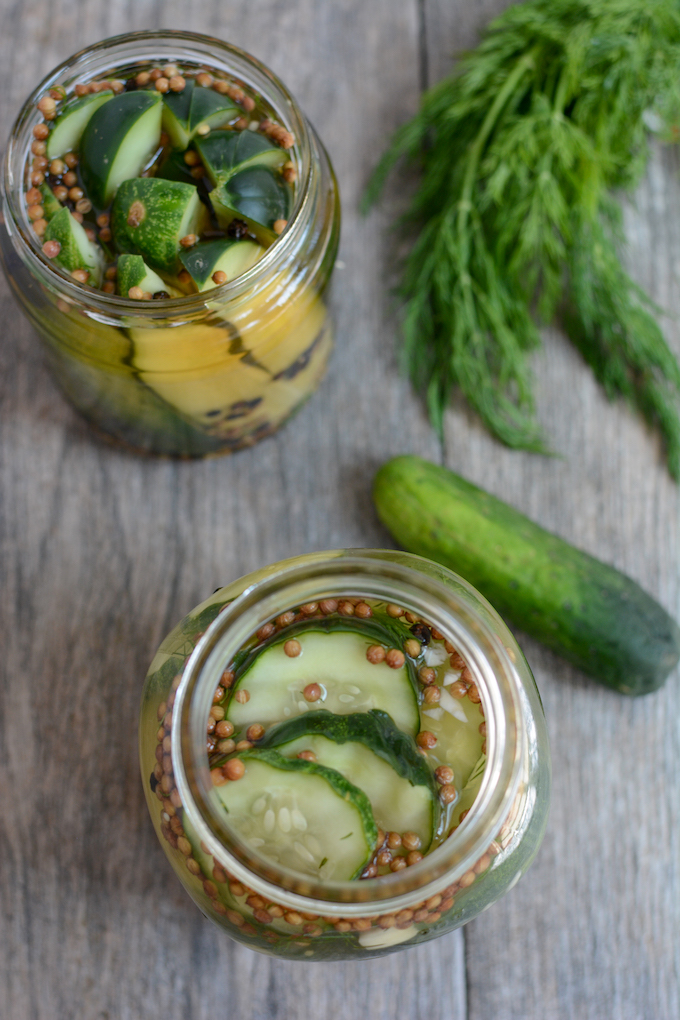
*Originally published 8/2011. Updated 8/2025*
This recipe for easy refrigerator pickles is no-canning and beginner friendly. It’s a budget-friendly alternative to traditional store-bought pickles.
Hi friends!
Let’s chat pickles. As far as food goes, I feel like pickles are one of the more polarizing ones – most people either love them or hate them. In our house, my husband and oldest son are huge pickle fans. So much so that I got tired of paying $6 a jar and decided to learn how to make my own just for them.
What are Refrigerator Pickles?
Refrigerator pickles are also known as quick pickles. They are made by simply submerging cucumbers in a vinegar-based brine and storing in the fridge versus traditional pickles, which go through the canning process.
Ingredients for Easy Refrigerator Pickles
To make these easy refrigerator pickles, you just need a few simple ingredients. Investing in jars of the spices will allow you to easily make many batches of refrigerator pickles. You’ll need:
- White vinegar – you can also use rice wine or apple cider vinegar
- Salt – kosher is best
- Sugar
- Coriander seeds
- Whole black peppercorns
- Whole mustard seeds
- Garlic – this is optional but adds more flavor
- Fresh dill
- Kirby cucumbers
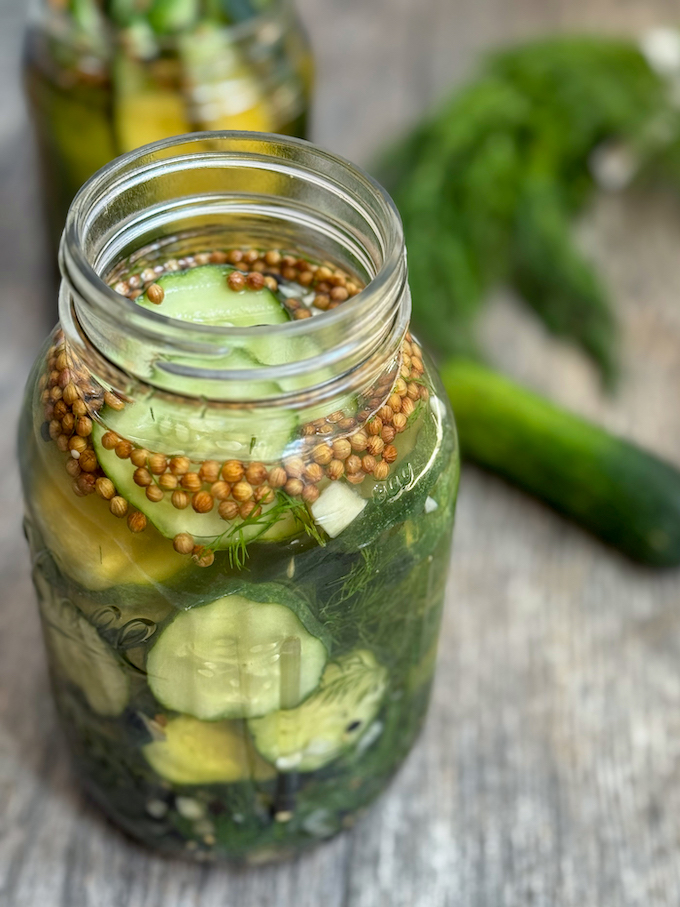
How To Make Refrigerator Pickles
Making easy refrigerator pickles requires just a few simple steps:
- Combine vinegar salt and sugar and bring to a boil to dissolve.
- Let cool and add cold water.
- Place cucumbers, dill, garlic and spices in a jar.
- Pour liquid into the jar.
- Secure the lid, shake well and let sit in the fridge for at least 24 hours.
What are the best pickles for easy refrigerator pickles?
My favorite pickles to use are Kirby pickles. They can often be bought in bulk in the produce section of the grocery store and they’re small and bumpy. Kirby pickles are the best choice if you like crisp, crunchy pickles!
What’s the best way to slice cucumbers for pickling?
You can slice them any way you want! Cut them lengthwise into spears or sandwich slices or cut them horizontally to make them more bite-sized. You can use a crinkle cutter when slicing as well! (aff link)
Refrigerator Pickles Variations
Spicy Refrigerator Pickles
To make your pickles spicier, add 1/2 tsp of red pepper flakes or add a serano or jalapeno sliced in half lengthwise to the jar.
Sweet Refrigerator Pickles // Bread and Butter Refrigerator Pickles
If you prefer a sweet pickle, you’ll need to add more sugar to the brine. I would suggest following a recipe specifically for sweet pickles like these Refrigerator Sweet Pickles.
Dill refrigerator pickles recipe
To me, dill pickles are the only kind, so this recipe includes dill. If you’re not a fan, you can leave out the sprigs of dill.
Can I make refrigerator pickles with other vegetables?
The good news about this brine is that you can use it to pickle a wide variety of vegetables. Try replacing the cucumbers with:
- sliced jalapenos
- thinly sliced red onions
- carrots
- green beans
Best Easy Refrigerator Pickle Recipe
Easy Refrigerator Pickles
These Easy Refrigerator Pickles are a simple, budget-friendly alternative to store-bought pickles.
Ingredients
- 3/4 cup white vinegar
- 1 Tbsp kosher salt
- 1 Tbsp sugar
- 1 cup cold water
- 1 Tbsp coriander seeds
- 1 Tbsp whole black peppercorns
- 1 tsp whole mustard seeds
- 3 cloves garlic, roughly chopped
- 8 sprigs fresh dill
- 3–4 Kirby cucumbers, quartered lengthwise (or sliced)
Instructions
- Combine vinegar, salt and sugar in a small saucepan. Bring to a boil and stir until dissolved.
- Let cool for 10 minutes, then add to cold water.
- In a 32 oz mason jar, combine the pickles, dill, garlic and seasoning.
- Pour liquid over top and refrigerate 24 hours before eating. You can add a little more water if needed.
- Store in the fridge for 3-4 weeks.
Notes
We sometimes reuse store-bought pickle jars instead of mason jars.
window.trCommon={“minRating”:6,”ajaxurl”:”https://www.theleangreenbean.com/wp-admin/admin-ajax.php”,”ratingNonce”:””,”postId”:3199};
window.TastyRecipes = window.TastyRecipes || {};
window.TastyRecipes.smoothScroll = {
init() {
document.addEventListener( ‘click’, ( e ) => {
let anchor = e.target;
if ( anchor.tagName !== ‘A’ ) {
anchor = anchor.closest( ‘a.tasty-recipes-scrollto’ );
}
if ( ! anchor || ! anchor.classList.contains( ‘tasty-recipes-scrollto’ ) ) {
return;
}
const elementHref = anchor.getAttribute( ‘href’ );
if ( ! elementHref ) {
return;
}
e.preventDefault();
this.goToSelector( elementHref );
});
},
goToSelector( selector ) {
const element = document.querySelector( selector );
if ( ! element ) {
return;
}
element.scrollIntoView( { behavior: ‘smooth’ } );
}
};
document.addEventListener(
‘DOMContentLoaded’,
() => window.TastyRecipes.smoothScroll.init()
);
window.TastyRecipes = window.TastyRecipes || {};
window.TastyRecipes.cookMode = {
wakeLockApi: false,
wakeLock: false,
cookModeSelector: ‘.tasty-recipes-cook-mode’,
init() {
if (“wakeLock” in navigator && “request” in navigator.wakeLock) {
this.wakeLockApi = navigator.wakeLock;
}
const cookModes = document.querySelectorAll(this.cookModeSelector);
if (cookModes.length > 0) {
for (const cookMode of cookModes) {
if (this.wakeLockApi) {
cookMode.querySelector(‘input[type=”checkbox”]’).addEventListener(“change”, event => {
this.checkboxChange(event.target);
}, false);
} else {
cookMode.style.display = “none”;
}
}
}
},
checkboxChange(checkbox) {
if (checkbox.checked) {
this.lock();
} else {
this.unlock();
}
},
setCheckboxesState(state) {
const checkboxes = document.querySelectorAll(this.cookModeSelector + ‘ input[type=”checkbox”]’);
for (const checkbox of checkboxes) {
checkbox.checked = state;
}
},
async lock() {
try {
this.wakeLock = await this.wakeLockApi.request(“screen”);
this.wakeLock.addEventListener(“release”, () => {
this.wakeLock = false;
this.setCheckboxesState(false);
});
this.setCheckboxesState(true);
} catch (error) {
this.setCheckboxesState(false);
}
},
unlock() {
if (this.wakeLock) {
this.wakeLock.release();
this.wakeLock = false;
}
this.setCheckboxesState(false);
}
};
(function(callback) {
if (document.readyState !== “loading”) {
callback();
} else {
document.addEventListener(“DOMContentLoaded”, callback);
}
})(() => {
window.TastyRecipes.cookMode.init();
});
window.TastyRecipes = window.TastyRecipes || {};
window.TastyRecipes.staticTooltip = {
element: null,
tooltipElement: null,
deleting: false,
init( element ) {
if ( this.deleting ) {
return;
}
this.element = element;
this.buildElements();
},
destroy() {
if ( ! this.tooltipElement || this.deleting ) {
return;
}
this.deleting = true;
this.tooltipElement.classList.remove( ‘opened’ );
setTimeout( () => {
this.tooltipElement.remove();
this.deleting = false;
}, 500 );
},
buildElements() {
const tooltipElement = document.createElement( ‘div’ );
tooltipElement.classList.add( ‘tasty-recipes-static-tooltip’);
tooltipElement.setAttribute( ‘id’, ‘tasty-recipes-tooltip’ );
const currentTooltipElement = document.getElementById( ‘tasty-recipes-tooltip’ );
if ( currentTooltipElement ) {
document.body.replaceChild( tooltipElement, currentTooltipElement );
} else {
document.body.appendChild( tooltipElement );
}
this.tooltipElement = document.getElementById( ‘tasty-recipes-tooltip’ );
},
show() {
if ( ! this.tooltipElement ) {
return;
}
const tooltipTop = this.element.getBoundingClientRect().top
+ window.scrollY
– 10 // 10px offset.
– this.tooltipElement.getBoundingClientRect().height;
const tooltipLeft = this.element.getBoundingClientRect().left
– ( this.tooltipElement.getBoundingClientRect().width / 2 )
+ ( this.element.getBoundingClientRect().width / 2 ) – 1;
const posLeft = Math.max( 10, tooltipLeft );
this.maybeRemoveTail( posLeft !== tooltipLeft );
this.tooltipElement.setAttribute( ‘style’, ‘top:’ + tooltipTop + ‘px;left:’ + posLeft + ‘px;’ );
this.tooltipElement.classList.add( ‘opened’ );
},
maybeRemoveTail( removeTail ) {
if ( removeTail ) {
this.tooltipElement.classList.add( ‘tr-hide-tail’ );
} else {
this.tooltipElement.classList.remove( ‘tr-hide-tail’ );
}
},
changeMessage( message ) {
if ( ! this.tooltipElement ) {
return;
}
this.tooltipElement.innerHTML = message;
}
};
window.TastyRecipes.ajax = {
sendPostRequest( url, data, success, failure ) {
const xhr = new XMLHttpRequest();
xhr.open( ‘POST’, url, true );
xhr.send( this.preparePostData( data ) );
xhr.onreadystatechange = () => {
if ( 4 !== xhr.readyState ) {
return;
}
if ( xhr.status === 200 ) {
success( JSON.parse( xhr.responseText ) );
return;
}
failure( xhr );
};
xhr.onerror = () => {
failure( xhr );
};
},
preparePostData( data ) {
const formData = new FormData();
for ( const key in data ) {
formData.append( key, data[key] );
}
return formData;
},
};
window.TastyRecipes.ratings = {
defaultRating: 0,
currentRatingPercentage: 100,
savingRating: false,
init( minRating ) {
this.minRating = minRating;
this.formWatchRating();
this.closeTooltipWhenClickOutside();
this.addBodyClassBasedOnSelectedRating();
this.backwardCompFormRatingPosition();
},
formWatchRating() {
const ratings = document.querySelectorAll(‘.tasty-recipes-no-ratings-buttons [data-rating]’);
if ( ratings.length {
event.preventDefault();
this.defaultRating = event.target.closest( ‘.checked’ ).dataset.rating;
this.setCheckedStar( event.target );
this.maybeSendRating( this.defaultRating, event.target );
this.setRatingInForm( this.defaultRating );
} );
}
},
closeTooltipWhenClickOutside() {
window.addEventListener( ‘click’, e => {
// Bailout (don’t remove the tooltip) when the clicked element is a rating star, or it’s the tooltip itself.
if ( e.target.closest( ‘.tasty-recipes-rating’ ) || e.target.classList.contains( ‘tasty-recipes-static-tooltip’ ) ) {
return;
}
window.TastyRecipes.staticTooltip.destroy();
} );
},
setRatingInForm( rating ) {
const ratingInput = document.querySelector( ‘#respond .tasty-recipes-rating[value=”‘ + rating + ‘”]’ );
if ( ! ratingInput ) {
return;
}
ratingInput.click();
},
addBodyClassBasedOnSelectedRating() {
const ratingInputs = document.querySelectorAll( ‘input.tasty-recipes-rating’ );
if ( ! ratingInputs ) {
return;
}
for ( const ratingInput of ratingInputs ) {
ratingInput.addEventListener( ‘click’, currentEvent => {
const selectedRating = currentEvent.target.getAttribute( ‘value’ );
this.handleBodyClassByRating( selectedRating );
this.toggleCommentTextareaRequired( selectedRating );
} );
}
},
handleBodyClassByRating( rating ) {
if ( rating < this.minRating ) {
document.body.classList.remove( 'tasty-recipes-selected-minimum-rating' );
return;
}
document.body.classList.add( 'tasty-recipes-selected-minimum-rating' );
},
toggleCommentTextareaRequired( rating ) {
const commentTextarea = document.getElementById( 'comment' );
if ( ! commentTextarea ) {
return;
}
if ( rating {
window.TastyRecipes.staticTooltip.changeMessage( response.data.message );
window.TastyRecipes.staticTooltip.show();
this.updateAverageText( response.data, recipeCardElement );
this.maybeFillCommentForm( response.data );
// Hide the tooltip after 5 seconds.
setTimeout( () => {
this.maybeResetTooltip( recipeCardElement, response.data, rating );
}, 5000 );
},
() => {
this.resetTooltip( recipeCardElement );
}
);
},
updateAverageText( data, recipeCardElement ) {
if ( ! data.average ) {
return;
}
this.setRatingPercent( data );
if ( ! data.count ) {
return;
}
const quickLink = document.querySelector( ‘.tasty-recipes-rating-link’ );
if ( quickLink ) {
this.setTextInContainer( quickLink, data );
this.setPartialStar( quickLink );
}
const cardStars = recipeCardElement.querySelector( ‘.tasty-recipes-ratings-buttons’ );
cardStars.dataset.trDefaultRating = data.average;
this.setTextInContainer( recipeCardElement.querySelector( ‘.tasty-recipes-rating’ ), data );
},
setTextInContainer( container, data ) {
if ( ! container ) {
return;
}
if ( data.label ) {
const ratingLabelElement = container.querySelector( ‘.rating-label’ );
if ( ratingLabelElement ) {
ratingLabelElement.innerHTML = data.label;
}
return;
}
const averageElement = container.querySelector( ‘.average’ );
if ( averageElement ) {
averageElement.textContent = data.average;
}
const countElement = container.querySelector( ‘.count’ );
if ( countElement ) {
countElement.textContent = data.count;
}
},
setPartialStar( container ) {
const highestStar = container.querySelector( ‘[data-rating=”‘ + Math.ceil( this.defaultRating ) + ‘”]’ );
if ( highestStar ) {
highestStar.dataset.trClip = this.currentRatingPercentage;
}
},
setRatingPercent( data ) {
this.defaultRating = data.average.toFixed( 1 );
const parts = data.average.toFixed( 2 ).toString().split( ‘.’ );
this.currentRatingPercentage = parts[1] ? parts[1] : 100;
if ( this.currentRatingPercentage === ’00’ ) {
this.currentRatingPercentage = 100;
}
},
setCheckedStar( target ) {
const cardRatingContainer = target.closest( ‘.tasty-recipes-ratings-buttons’ );
const selectedRatingElement = cardRatingContainer.querySelector( ‘[data-tr-checked]’ );
if ( selectedRatingElement ) {
delete selectedRatingElement.dataset.trChecked;
}
const thisStar = target.closest( ‘.tasty-recipes-rating’ );
thisStar.dataset.trChecked = 1;
thisStar.querySelector( ‘[data-tr-clip]’ ).dataset.trClip = 100;
},
maybeFillCommentForm( data ) {
if ( ! data.comment || ! data.comment.content ) {
return;
}
const commentForm = document.querySelector( ‘#commentform’ );
if ( ! commentForm ) {
return;
}
const commentBox = commentForm.querySelector( ‘[name=comment]’ );
if ( ! commentBox || commentBox.value ) {
return;
}
// Add comment details for editing.
commentBox.innerHTML = data.comment.content;
if ( data.comment.name ) {
commentForm.querySelector( ‘[name=author]’ ).value = data.comment.name;
commentForm.querySelector( ‘[name=email]’ ).value = data.comment.email;
}
},
maybeResetTooltip( recipeCardElement, data, rating ) {
if ( this.savingRating === rating ) {
this.resetTooltip( recipeCardElement, data );
}
},
resetTooltip( recipeCardElement, data ) {
window.TastyRecipes.staticTooltip.destroy();
this.savingRating = false;
// Reset the default rating.
const cardRatingContainer = recipeCardElement.querySelector( ‘.tasty-recipes-ratings-buttons’ );
if ( cardRatingContainer ) {
this.defaultRating = ( data && data.average ) ? data.average.toFixed(1) : cardRatingContainer.dataset.trDefaultRating;
cardRatingContainer.dataset.trDefaultRating = this.defaultRating;
this.resetSelectedStar( cardRatingContainer, data );
}
},
resetSelectedStar( cardRatingContainer ) {
const selectedRatingElement = cardRatingContainer.querySelector( ‘[data-rating=”‘ + Math.ceil( this.defaultRating ) + ‘”]’ );
if ( selectedRatingElement ) {
selectedRatingElement.querySelector( ‘[data-tr-clip]’ ).dataset.trClip = this.currentRatingPercentage;
selectedRatingElement.parentNode.dataset.trChecked = 1;
}
const previousSelectedElement= cardRatingContainer.querySelector( ‘[data-tr-checked]’ );
if ( previousSelectedElement ) {
const currentSelectedRating = previousSelectedElement.querySelector(‘[data-rating]’);
if ( currentSelectedRating !== selectedRatingElement ) {
delete previousSelectedElement.dataset.trChecked;
}
}
},
backwardCompFormRatingPosition() {
const ratingsButtons = document.querySelector( ‘#respond .tasty-recipes-ratings-buttons, #tasty-recipes-comment-rating .tasty-recipes-ratings-buttons’ );
if ( ! ratingsButtons ) {
return;
}
const ratingsButtonsStyles = window.getComputedStyle(ratingsButtons);
if ( ! ratingsButtonsStyles.display.includes( ‘flex’ ) ) {
ratingsButtons.style.direction = ‘rtl’;
}
if ( typeof tastyRecipesRating !== ‘undefined’ ) {
// Select the rating that was previously selected in admin.
ratingsButtons.querySelector( ‘.tasty-recipes-rating[value=”‘ + tastyRecipesRating + ‘”]’ ).checked = true;
}
const ratingSpans = ratingsButtons.querySelectorAll( ‘.tasty-recipes-rating’ );
for (const ratingSpan of ratingSpans) {
ratingSpan.addEventListener( ‘click’, event => {
if ( ratingSpan === event.target ) {
return;
}
ratingSpan.previousElementSibling.click();
} );
}
}
};
(function(callback) {
if (document.readyState !== “loading”) {
callback();
} else {
window.addEventListener( ‘load’, callback );
}
})(() => {
window.TastyRecipes.ratings.init( window.trCommon ? window.trCommon.minRating : 4 );
});
Easy Refrigerator Pickles FAQs
How long do refrigerator pickles last?
These pickles should last 3-4 weeks in the fridge! After that the quality may start to degrade.
Can I reuse the brine?
Yes! If you finish your pickles in the first week or two, feel free to add another batch of cucumbers to the brine.
How soon can you eat refrigerator pickles?
These pickles are ready to eat in 24 hours! They can be eaten before that but the flavor may not be fully developed.
How to serve refrigerator pickles?
Serve them straight out of the jar for snacking or make them crinkle-cut and add to burgers, sandwiches and charcuterie boards.
Can I use apple cider vinegar in refrigerator pickles?
Yes, feel free to substitute apple cider or rice wine vinegar for the white vinegar in this recipe.
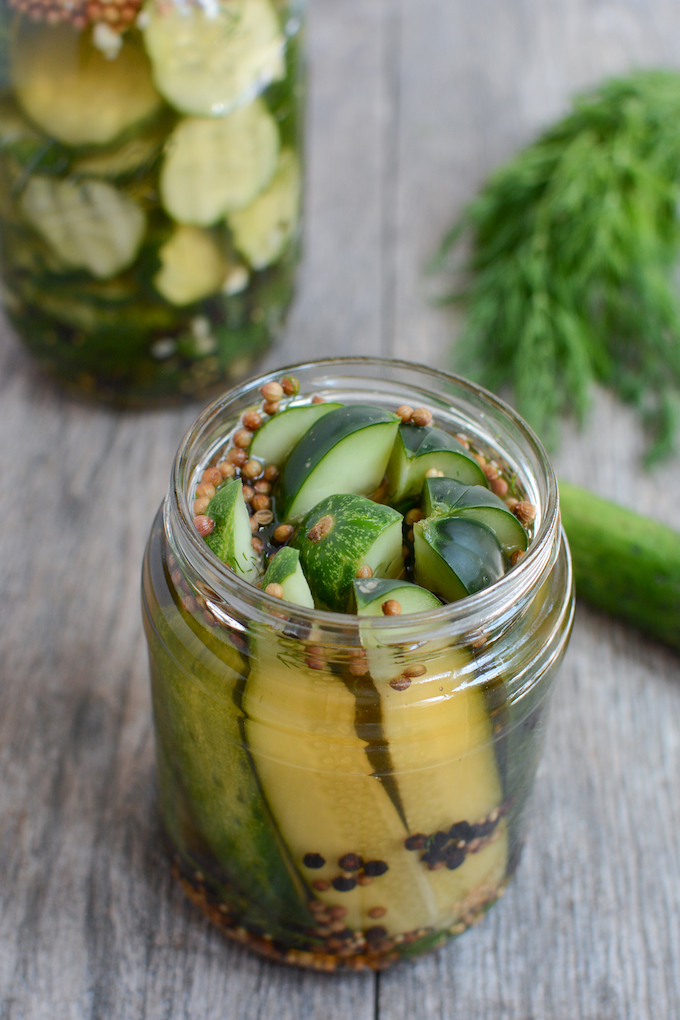
Can you make refrigerator pickles without sugar?
Yes, if that fits your taste preferences, you can omit the sugar in this recipe.
Can I freeze refrigerator pickles?
I would not recommend it. But you can freeze sprigs of fresh dill so that you always have those on hand for pickling!
What’s the best container to store refrigerator pickles?
My favorite container is actually to reuse a glass jar from store-bought pickles. You can use any glass jars – 32 oz mason jars work well. Or get a pickle jar like this! (aff link)
Are refrigerator pickles safe for kids to eat?
Yes! Kids can definitely enjoy these pickles.
Do I need to boil the vinegar for refrigerator pickles?
Boiling helps dissolve the salt and sugar and combine the flavors but boiling isn’t required. Especially if you like very crunchy pickles, you can skip this step if you want to.
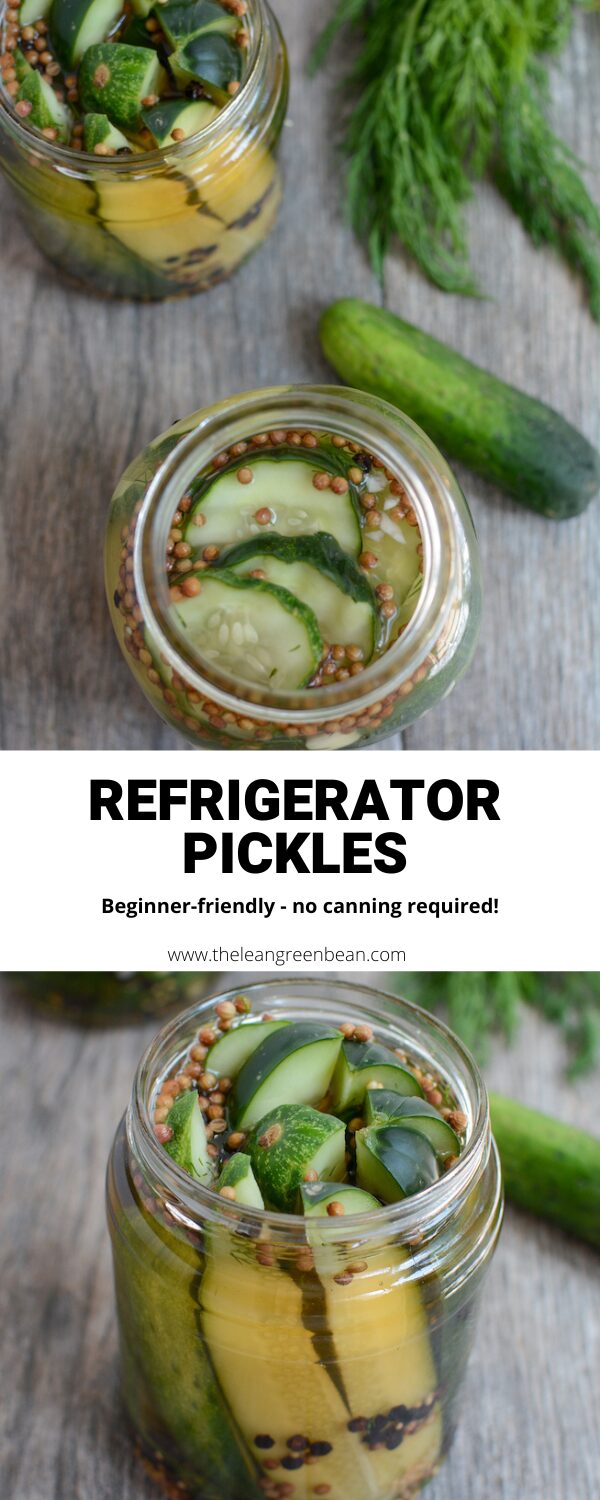
These easy refrigerator pickles are crunchy, tangy and even better than store-bought! They’re quick, affordable, and easy to customize!
Want more easy homemade recipes? Try
- Homemade Soft Pretzels
- Homemade Whole Wheat Pancakes
- Homemade Pizza Dough
Enjoy!
–Lindsay–


